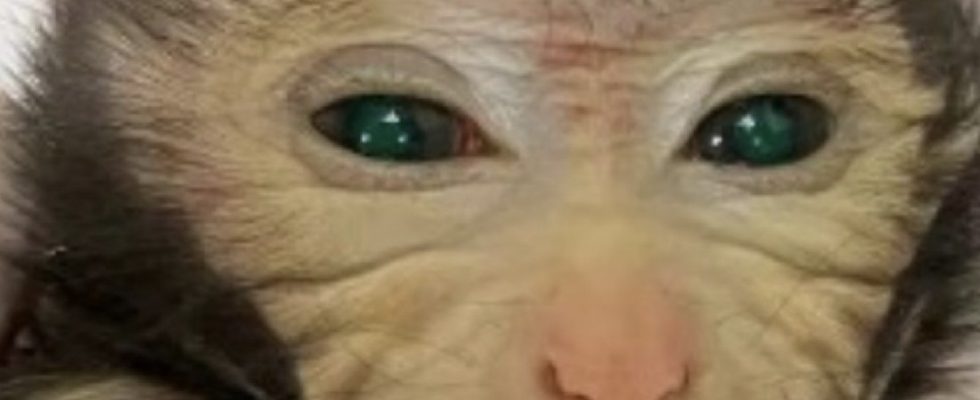At first glance, the dots in the monkey’s eyes look like reflections. But then, well, they’re green? What’s shimmering are cells that have been implanted with a gene that makes them glow green. The animal’s fingertips also shine in the same color. It is proof that a research group in China has managed to create a living chimera – a monkey with cells from two creatures. Previously, something similar had only been achieved with mice and rats, and never with such a large animal.
To do this, the team led by Zhen Liu from the Cebsit Research Center of the Chinese Academy of Sciences in Shanghai injected elaborately prepared stem cells from cynomolgus monkeys in the laboratory into embryos of other cynomolgus monkeys. The team created over 200 embryos in this way. After these had matured into so-called blastocysts in the laboratory, the team was able to detect a green glow in 74 of these cell clusters. This came from a protein that they inserted into the injected stem cells as a signal. Every cell that glows green comes from the stem cells and not from the treated monkey embryo.
The research group flushed the 74 glowing blastocysts into the uteruses of 40 female monkeys, resulting in twelve pregnancies. Six of the fetuses died before birth, six were born alive, only one of the newborns, the monkey with number ten, showed chimeric properties in the analyzes, recognizable by a green glow in some tissues. Eyes, fingertips, lungs, liver and brain had 20 to 90 percent cells glowing green – a clear sign that number ten was a hybrid of two animals whose cells functioned together.
However, they didn’t do it particularly well. Monkey number ten had difficulty breathing and temperature regulation. He was euthanized ten days after his birth. “You have to ask yourself whether these studies justify the suffering that they have caused,” says Stefan Schlatt, director of the Center for Reproductive Medicine and Andrology at the University Hospital of Münster, who himself also carries out experiments on primates.
In the future, human replacement organs could grow in chimeras
Most experts no longer doubted that it was fundamentally possible to create a monkey chimera using stem cells after rats and mice, but no one had ever undertaken the hard work of actually showing it. “The paper shows that the systematic and laborious search for optimal culture conditions and experimental setups is necessary to move from a fundamental discovery to an efficient application,” says Schlatt. This must be “viewed as a fundamental scientific breakthrough.” At the same time, the result shows “that the offspring are unhealthy and cannot survive for more than a few days. This is a clear indication that chimerism, in whatever form, is not a strategy for human use.”
Monkey number ten on the third day after birth: the skin, eyes and fingertips appear greenish due to the added stem cells.
(Photo: Cell/Cao et al.)
According to Schlatt, the paper shows how difficult it is to create living chimeric animals. “In the long term it will hardly be possible to give birth to hybrids of two species alive.” Rüdiger Behr from the German Primate Center in Göttingen sees potential future applications in two areas in particular: in researching ways to produce organs from human cells in animals and in the development and testing of new therapies. Hearts or livers could possibly grow from human stem cells in chimeric pigs, says Behr.
Because of their size, pigs are far more suitable for this purpose than cynomolgus monkeys. They are also easier to breed. But for Stefan Schlatt, the new work falls into the area of basic research. The formation of chimeras in cynomolgus monkeys primarily demonstrates the adaptive abilities of the injected stem cells: they were able to take on many different roles in the embryo. Javanese monkeys are primates, just like humans. “The work is another exciting basic science breakthrough in stem cell technology and developmental biology,” says Schlatt. “Slowly but surely, the mysteries at the beginning of life are being solved. At the same time, we are learning how crucial cellular states and synchronization are in the formation of an organism.”
With material from the Science Media Center.

